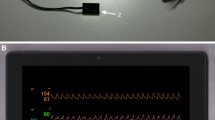Summary
In a study on 29 patients for 152 hours a continuous monitoring system has been shown to have a reliability of 90.53 % for pulse rate and 82.20% for arterial blood pressure, but for approximately half of the period of unreliable monitoring a not obviously artifactual reading was being displayed. The relevance of this to possible incorrect diagnosis and management is discussed. The monitor and a nurse using traditional chart keeping methods gave equivalent charts with respect to average levels and trends, but the monitor assisted chart showed a much greater variability. The latter tended to obscure underlying trends and render clinical diagnosis from the chart more difficult
Similar content being viewed by others
References
Arbeit, S. R., Rubin, I. L., Gross, H.: ”Danger of interpreting E.C.G's from oscilloscopes.” Journal of the American Medical Association 211, 453–456 (1970)
Ashworth, P. M.: “Intensive Care.” Nursing Mirror 128, 20–21 (1968)
Davenport, W. B., Root, W. L.: “An Introduction to the Theory of Random Signals and Noise.” New York: McGraw-Hill 1958
Evans, T. R., Clarke, T. J. H.: “Reliability of patient monitoring apparatus.” British Medical Journal 2, 734–736 (1971)
Feinstein, A. R.: In: “Clinical Judgement”, p. 291. Baltimore: Williams & Williams 1967
Gump, F. E.: “Physiological measurements and their interpretation.” Medical Clinics of North America 55, 1141–1155 (1971)
Hope, C. E., Lewis, C. D., Perry, I. R., Gamble, A.: “Computer trend analysis in automated patient monitoring systems.” British Journal of Anaesthesia 45, 440–448 (1973)
Lewis, C. D.: “Statistical monitoring techniques.” Medical Biological Engineering 9, 315–323 (1971)
Lewis, G. N.: “Monitoring of patients in Intensive Care Units.” Surgical Clinics of North America 51, 15–23 (1971)
Maloney, J. V.: “The trouble with patient monitoring.” Annals of Surgery 168, 605–619 (1968)
Neumann, J. von, Kent, R. H., Bellinson, N. R., Hart, B. I.: Annals of Mathematical Statistics 12, 153 (1941)
Otterman, J.: “The properties and methods of computation of exponentially mapped past statistical variables.” Institute of Radio Engineers Transactions on Automatic Control AC-5, 11–17 (1960)
Taylor, D. E. M.: “Computer assisted patient monitoring.” Biomedical Engineering 6, 560–566 (1971)
Taylor, D. E. M.: “Interaction of Men and Machines in Intensive Care Units.” In: “Intensive Care”, Proceedings of 8th International Pfizer Symposium. D. E. M. Taylor, J. Walker (Eds.). Edinburgh and London: Churchill-Livingstone 1975
Taylor, D. E. M., Hitchings, D. J.: The development and assessment of a computer assisted monitor alarm and warning system (PAWS). Bio-medical Engineering (1974). In press.
Taylor, D. E. M., Whamond, Joan S., Hitchings, D. J., Hulliger, M., Begg, D.: Short term variability of pulse rate and blood pressure in post-operative cardiac surgical patients. Cardiovasc. Res. (1975). In press.
Author information
Authors and Affiliations
Rights and permissions
About this article
Cite this article
Taylor, D.E.M., Whamond, J.S. Reliability of human and machine measurements in patient monitoring. Europ. J. Intensive Care Med 1, 53–59 (1975). https://doi.org/10.1007/BF00626426
Issue Date:
DOI: https://doi.org/10.1007/BF00626426




